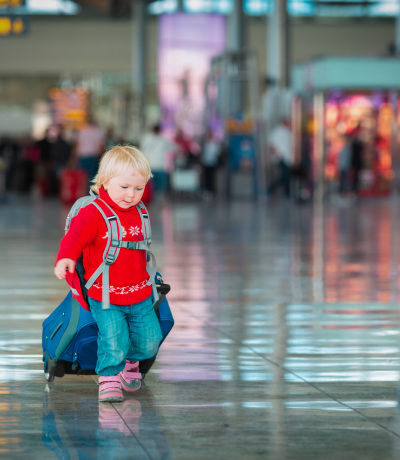How to Travel Safely and Solo with Kids
9 December 2023
For decades, the number of US children living with a single parent has been rising, accompanied by declining marriage rates and rising births outside of marriage. According to the US Census Bureau, almost a quarter (23%) of US children under 18 now live with one parent and no other adults―more than three times the share of children around the world who do the same.
More single parents are also braving the challenge of traveling solo with their children, and the increase in remote work has helped single parents rediscover themselves and their children through travel.
Single parents and those traveling solo with their children are shining examples of strength and resilience, and the people choosing to be parents these days want more for their kids.
So, if you are a parent considering traveling with your kids on your own, or know someone who is, what are the essential safety rules for traveling solo with kids? We researched to find out.

1. Research the destination carefully
Choosing the right destination, and knowing what to expect (as much as possible) when you arrive is essential to any successful trip and even more so when traveling solo with children.
Follow this checklist:
- Watch your layover times carefully – these can be helpful ways to burn off pent-up energy or (if too short) a stressful nightmare.
- Choose safe lodging with on-site amenities like free breakfast – gentler mornings with food make a difference!
- Book lodging with airport pickup or schedule a driver to meet you at the airport – you do not want to figure this out with a sleeping child on your shoulder.
- Learn how you’ll get around before you go and how far you’ll need to travel to see the attractions on your list.
- Book advance tickets that have free cancellation – this can save you lots of money if things go sideways and you decide the kids need a day at the pool rather than the theme park.
- Consider reimplementing a stroller even if you’ve given up on using one. Sometimes kids behave very differently on a trip or get tired more quickly than at home.
2. Break long travel into shorter sections
Getting on a plane – check! Then getting on a bus, followed by a boat, and then a ride-share might be too much for you and the kids to endure all at one go.
Consider breaking up longer sections of travel with an overnight stop for some food, wandering, and rest. Travel is an adventure, and it’s a lot of stimulus for little people, so they’ll get tired more quickly or get amped up and fussy.
It’s important to go with a full understanding of the reality of getting there first. Make sure your destination, however idyllic it will be when you arrive, isn’t too difficult to get to.
See also: 5 tips to prepare for a safe long-haul flight with young kids.
3. Get a notarized letter from the parent staying home
As the world grows more aware of child trafficking, you want to be prepared to prove that you’re not stealing your child. You want to be sure you have the right documents for your trip.
Essentially, this breaks down into the following steps:
- If the child has a second parent, get a notarized letter of consent from that parent.
- If the traveling parent has sole custody, carry a copy of the custody document.
- If the child has only one parent, carry a copy of their birth certificate showing yourself as the single parent.
See the US Department of State information about traveling with children to ensure you have the right documentation.
4. Leave a copy of your itinerary with someone at home
Always let someone know your itinerary and who you’ll be traveling with. If you’re meeting someone at your destination, share that info with them too.
This way, someone else is aware of your travel plans and can be contacted in an emergency.
Pro tip: Share a copy of your travel insurance documentation with them too. They can contact the travel insurance company for support if you are incapacitated and your child needs help.
5. Consolidate everything
When you’re traveling solo, you have exactly your hands to work with – no others. Combine and consolidate all the items you can, including:
- Packing a single suitcase for you and the kids
- Rent or borrow equipment (like a travel crip) at your destination
- Carry a single backpack on the plane rather than a purse, laptop, and diaper bag
- Edit down all the contents of your bag – you can live without diaper rash cream on the plane and buy it when you arrive
- Pack a romper or pajamas as the backup instead of an extra outfit
6. Get travel insurance – no kidding
There are plenty of trips where a traveling adult doesn’t need travel insurance, but no solo trip with kids falls into that category.
Seriously.
Imagine these scenarios:
- The night before your trip abroad, your child spikes a fever.
- You arrive at your destination with a backpack and child, but your baggage, including the car seat, doesn’t.
- On the return trip, a snowstorm grounds all flights, and you have to find a place to stay for a couple of nights.
- On your trip, you are in an accident and hospitalized – who will take care of your child?
These are not imaginary situations; they are real challenges parents face when they travel. Travel insurance can be a lifesaver in all these situations.
Bonus: Many travel insurance plans offer free coverage for children under 17 or 18.
Remember that novelty goes a long way too. While airplane snacks may not qualify for your usual standard of healthy, they are new, and that makes them special. A small new toy can be exciting, and that makes it worth its weight in joy and entertainment.
7. Have a plan if you get separated
Before the trip, and if they are old enough, make sure they understand the rules and what they should do if things go wrong. Specifically,
- Make sure the kids know your phone number.
- Create a plan if you get separated (see more below).
- Take photos of your child each morning so you can describe what they are wearing.
If your child isn’t old enough to memorize a phone number, consider writing it in marker on their clothing or invest in temporary tattoos with your name and number. You can also consider purchasing a bracelet with your contact information, or even attach an Airtag to your child for extra peace of mind.
Related topics
Damian Tysdal is the founder of CoverTrip, and is a licensed agent for travel insurance (MA 1883287). He believes travel insurance should be easier to understand, and started the first travel insurance blog in 2006.
